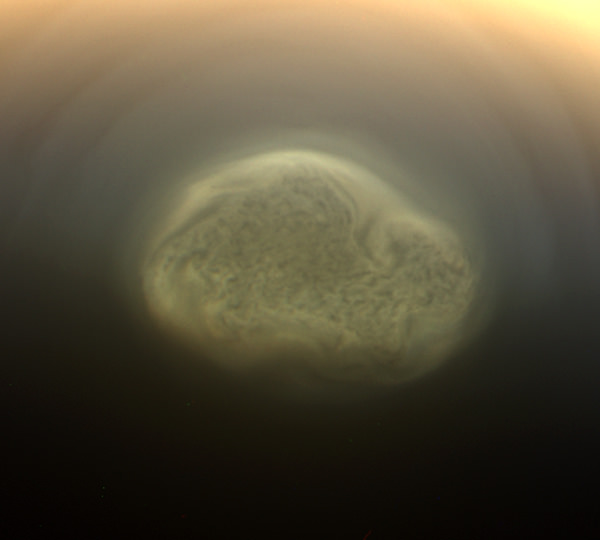Thanks to Cassini’s new vantage point granted by its inclined orbit researchers have gotten a new look at the south pole of Titan, Saturn’s largest moon. What they’ve recently discovered is a swirling vortex of gas forming over the moon’s pole, likely the result of the approach of winter on Titan’s southern hemisphere.
What we’re seeing here is thought to be an open cell convection process in Titan’s upper atmosphere. In open cells, air sinks in the center of the cell and rises at the edge, forming clouds at cell edges. However, because the scientists can’t see the layer underneath the layer visible in these new images, they don’t know what other mechanisms may be at work.
A stable atmospheric event that’s found here on Earth as well, open cell convection can be compared to the action of boiling water.
Titan has already been seen to have a thicker area of high-altitude haze over its north pole, and as autumn progresses toward winter in Titan’s south during the course of Saturn’s 29.7-year-long orbit this may very well be the beginnings of a southern polar hood.
An animation of this southern vortex can be found here.
“We suspect that this maelstrom, clearly forming now over the south pole and spinning more than forty times faster than the moon’s solid body, may be a harbinger of what will ultimately become a south polar hood as autumn there turns to winter. Of course, only time will tell.”
– Carolyn Porco, Cassini Imaging Team Leader
Discoveries like this are prime examples of why it was so important for Cassini to have an extended, long-duration mission around Saturn, so that seasonal changes in the planet and moons could be closely observed. New seasons bring new surprises!
The southern vortex structure was also captured in raw images acquired by Cassini on June 28. A color-composite made from three of those raw images is below (the vortex can be seen at center just right of the terminator):
You can find more images from Cassini on the CICLOPS Imaging Team site.
Image credits: NASA/JPL/Space Science Institute. Bottom RGB composite by Jason Major.


